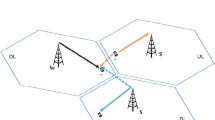Abstract
Recently, a new method for achieving spectrum reuse in cellular systems, called Capture‐Division Packet Access (CDPA), has been introduced. The method uses a single frequency in all cells, and exploits packet switching and packet retransmission as a means to overcome destructive cochannel interference. As the CDPA key factor is packet retransmission, it is also very effective in fighting lognormal shadowing attenuation as long as this attenuation can be considered independent from slot to slot. In this paper we analyze CDPA in presence of “slow shadowing”, to account for situations in which obstacles obscure the receiver for several transmission periods. The results show a severe throughput impairment with respect to the “fast shadowing” model. A variation of CDPA, Macrodiversity CDPA, that uses three corner fed antennas and three packet receivers is analyzed. The numerical results show that M‐CDPA is more efficient than CDPA and that it is only slightly affected by both fast and slow shadowing. To further investigate its robustness, a non‐lognormal slow shadowing model, the hard shadowing model, is also analyzed.
Similar content being viewed by others
References
N. Abramson, The throughput of packet broadcasting channels, IEEE Trans. Comm. 25 (January 1977) 117–128.
G. Bianchi, F. Borgonovo, M. De Marco and V. Trecordi, A simulation study of cellular systems based on the Capture-Division Packetized Access (CDPA) technique, in: '95, Seattle, WA (June 1995) pp. 1399–1403.
G. Bianchi, F. Borgonovo, L. Fratta, L. Musumeci and M. Zorzi, C-PRMA: the Centralized Packet Reservation Multiple Access for local wireless communications, in: '94 (November 1994) pp. 1340–1345.
F. Borgonovo, M. Zorzi and L. Fratta, Antenna sectorization and macrodiversity in CDPA wireless systems, in: '95 (November 1995) pp. 610–614.
F. Borgonovo, M. Zorzi, L. Fratta, V. Trecordi and G. Bianchi, The Capture-Division Packet Access (CDPA) for wireless personal communications, IEEE J. Selected Areas Comm. 14 (May 1996) 609–622.
K.S. Gilhousen, I.M. Jacobs, R. Padovani, A.J. Viterbi, L.A. Weaver, Jr, and C.E. Wheatley III, On the capacity of a cellular CDMA system, IEEE Trans. Vehicular Technol. 40 (May 1991) 303–312.
W.C. Jakes, Jr, ed., Microwave Mobile Communications (Wiley, New York, 1974).
J. Walker, Mobile Information Systems (Artech House, 1990).
M. Zorzi, F. Borgonovo and L. Fratta, Packet access for cellular systems: the capacity of S-ALOHA and CDPA with slow varying shadowing, in: '96, Paris, France (May 1996), (Kluwer) pp. 87–102.
M. Zorzi and S. Pupolin, Outage probability in multiple access packet radio networks in the presence of fading, IEEE Trans. Vehicular Technol. 43 (August 1994) pp. 604–610.
M. Zorzi and S. Pupolin, Slotted aloha for high capacity voice cellular communications, IEEE Trans. Vehicular Technol. 43 (November 1994) 1011–1021.
Author information
Authors and Affiliations
Rights and permissions
About this article
Cite this article
Borgonovo, F., Zorzi, M. & Fratta, L. Slow shadowing and macrodiversity in the Capture‐Division Packet Access (CDPA). Wireless Networks 3, 113–120 (1997). https://doi.org/10.1023/A:1019136713141
Issue Date:
DOI: https://doi.org/10.1023/A:1019136713141




